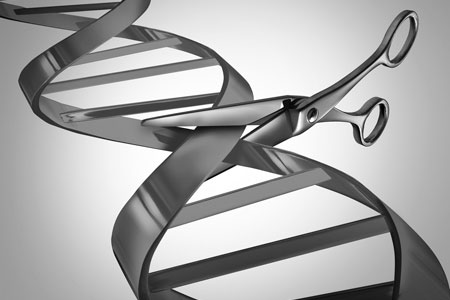 The use of CRISPR/Cas9 has profoundly affected mouse genetics by reducing the cost and the timeline associated with the introduction of mutations in the genome. But is it possible that CRISPR isn't specific enough for the generation of genetically engineered animal models?
The use of CRISPR/Cas9 has profoundly affected mouse genetics by reducing the cost and the timeline associated with the introduction of mutations in the genome. But is it possible that CRISPR isn't specific enough for the generation of genetically engineered animal models? Since its appearance, the technology has been used to generate thousands of new animal models used in both basic and preclinical research. However, the possibility that, while modifying the target site, Cas9 could introduce additional unwanted mutations, called off-targets, has haunted hundreds of researchers that have used this technology to generate their models.
Do Off-Target Mutations Undermine CRISPR/Cas9?
Our current understanding of the mechanism of action of the CRISPR/Cas9 system suggests that off-targets should share at least some sequence identity with the target site, and that the partial base pairing of the guide RNA on the genomic DNA causes the off-target mutations. Since potential off-targets are similar to the target sequence, it is possible to predict their genomic location and analyze their integrity in newly generated models. Multiple groups reported that modification of the predicted off-target sites in mice is a very uncommon event, putting the minds of many researchers at rest1,2.Therefore, many scientists were taken by surprise when Schaefer et al. published a report in the 2017 March issue of Nature Methods suggesting that the CRISPR/Cas9 system introduces many thousands of off-target mutations in the mouse genome3. Even more worryingly, the vast majority of these mutations did not share any similarity with the target site. In other words, off-target mutations would be completely unpredictable.
The data from Schaefer et al. implied that all models generated using this approach were intrinsically flawed. Additionally, these observations suggested that the lack of specificity of the CRISPR/Cas9 system would preclude its use for gene therapy. Accordingly, the stocks of companies that had invested in the clinical applications of CRISPR stumbled.
Potential Methodological Flaws
Perhaps the most surprising observation reported in the Nature Methods article was that homozygous single-nucleotide exchanges represented the vast majority of the off-target modifications. Since mutational events triggered by the activity of Cas9 are usually microdeletions, these observations suggested the existence of a very efficient and yet still unknown mode of action of CRISPR/Cas9.Moreover, scientists in the field were amazed that animals carrying such a mutational load could be viable and show no overt phenotypes. A critical evaluation of the data presented in the paper revealed some potential flaws in the experimental design. Specifically, the animals used for the analysis were not directly related (e.g., parents and progeny), but merely shared a common background. Careful bioinformatic examination of the results by another group suggested that the alleged off-target mutations could be nothing else than pre-existing genomic variants between the Cas9-treated animals and the control mice4.
Despite these issues, Schaefer et al. have stood by their results, vigorously defending their interpretation of the data. Since no alternative data for the analysis of the genetic integrity of mouse lines generated by CRISPR/Cas9 were publicly available at the time, the controversy remained unresolved — until now.
Studying Off-Target Mutations in CRISPR Animal Models
A new paper in bioXriv is finally addressing the absence of an alternative set of data5. Vivek Iyer and colleagues at the Wellcome Sanger Institute in the UK performed a careful and extensive analysis of full genome sequencing data obtained from a large number of CRISPR-Cas9-treated and control animals. Importantly, Iyer et al. used the parents of the CRISPR/Cas9-treated mice as controls to detect de novo mutations and avoid any confounding effects caused by variations that might be present in different mouse subpopulations.Their conclusion is very clear: the mutation rate associated with the use of the CRISPR/Cas9 system is not distinguishable from the background mutation frequency that characterizes normal embryonic development.
While contradicting the article by Schaefer et al., these new data are in agreement with the initial reports of low off-target modification rate, suggesting that the thousands of mutations described in the Nature Method article are nothing else than natural variations present in different mouse populations.






.jpg)

.jpg)
.jpg)
.jpg)
.jpg)





.jpg)
.jpg)


.jpg)



.jpg)




.jpg)

.jpg)
.jpg)






